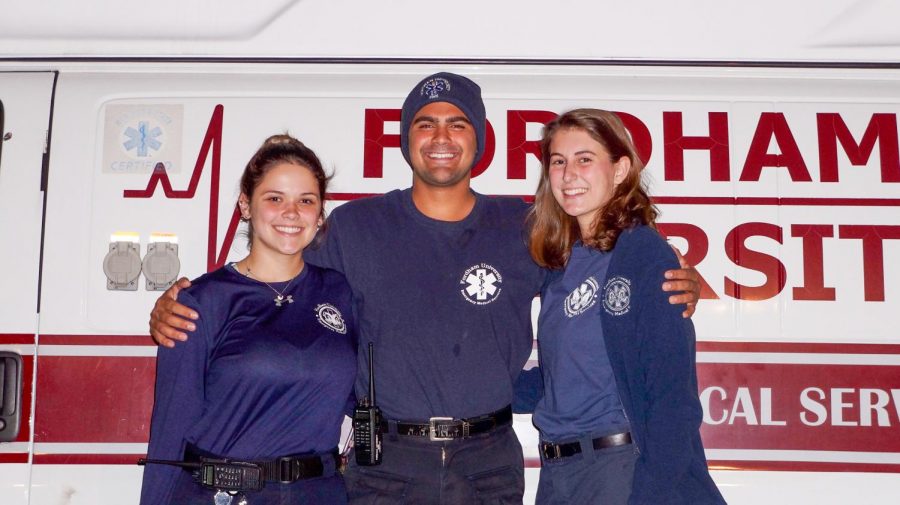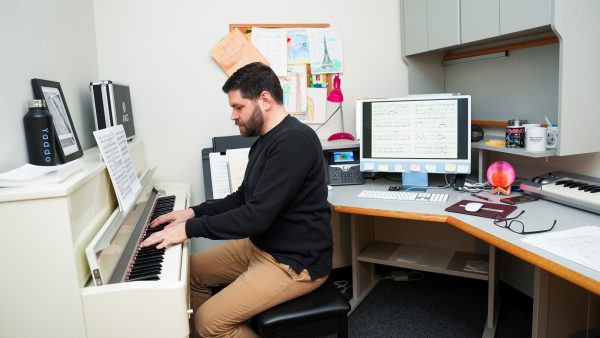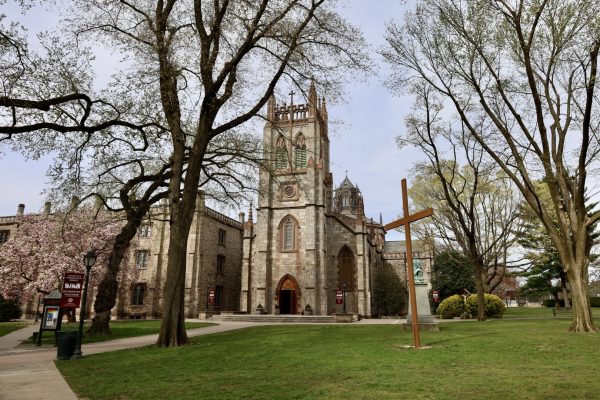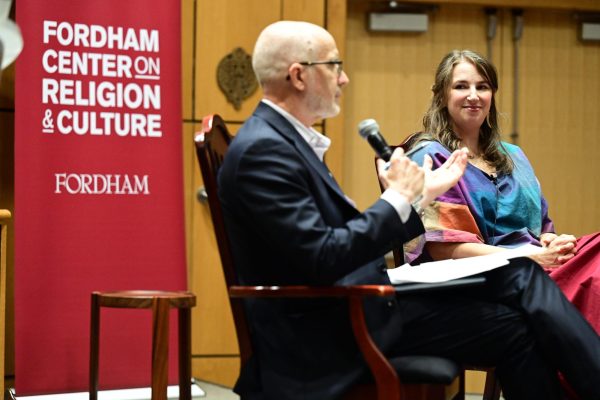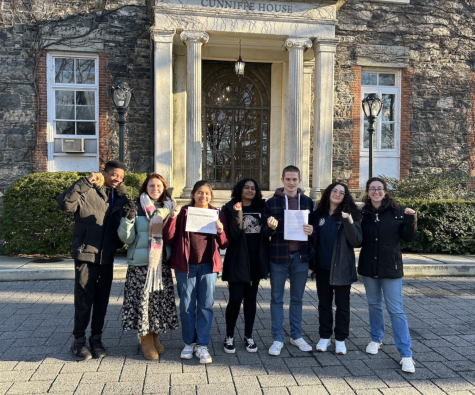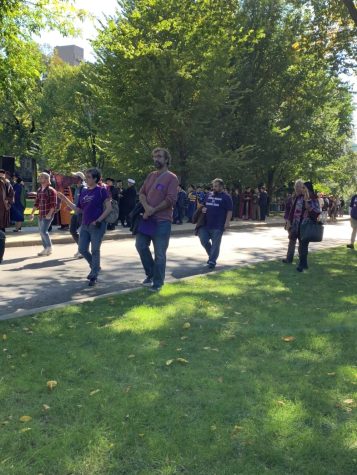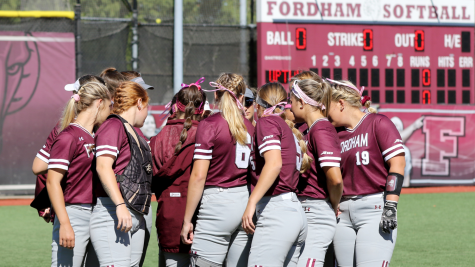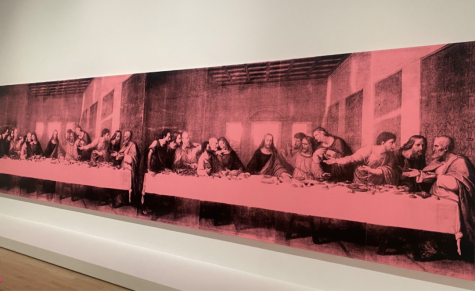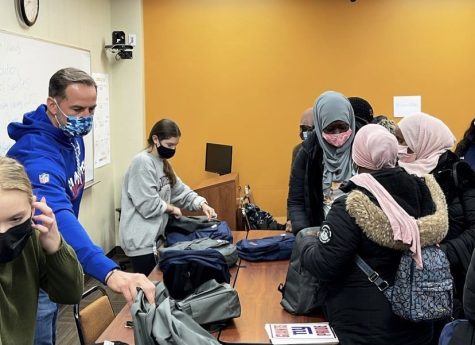FUEMS Maintains Ties to St. Barnabas Hospital
Jennifer Hoang/The Fordham Ram
FUEMS is a tight knit family that spends long shifts together.
On the first truly cold night in October, on duty members of Fordham University EMS (FUEMS) cleaned the office together — containers of leftover french fries littered the table and the smell of empanadas lingered from that night’s dinner. Laughter permeated through the office’s crevices, past the handheld radios, piles of EMT jackets and buckets of coffee creamers. Amidst the chatter of weekend plans and complex medical jargon, one member ran through a mock emergency as the other feverishly took notes. All was still before 10:30 p.m., when the crew’s first call of the night came in.
“Is it nighttime or daytime,” asked Gabrielle Ma, FCRH ’20, a crew chief on FUEMS, evaluating the patient outside a university entrance.
“Daytime,” responded the patient.
For the 150 members of the organization that provides 24/7 EMS coverage on and around the university’s campus, timing and coordination is everything.
As Ma lifted the patient onto the stretcher, Adam Rosen, FCRH ’20, an EMT, began taking the patient’s vitals. Yianni Flouskakos, FCRH ’20, chief of FUEMS, oversaw the situation, talked to Public Safety and addressed the patient’s friends. A new member, Sophia DeRosa, FCRH ’23, stood close to assist. The crew pulsated in sync surrounding the patient, an orchestra of arms swung in succession for the stretcher, its straps and a stethoscope.
In the driver’s seat sat Mike Aman, FCRH ’20, a longtime crew chief and driver, navigating toward one of several routes he has memorized to the closest hospital and one FUEMS transports to most often, St. Barnabas.
“They know us. They respect us. They look out for our students,” said Flouskakos, referring to the staff at St. Barnabas. “I say this and I mean this whole heartedly, if anything were to happen to me and these guys picked me up, I would tell them to take me to St. Barnabas.”
Flouskakos said he hopes to debunk the stigma surrounding the hospital and explained the organization’s reasoning for its longstanding and close relationship with the hospital — it is the only hospital the organization has a personal connection with and its medical director, Mark Estrellado, M.D., FCRH ’09, an ER attending at St. Barnabas, is notified of every FUEMS transport.
“Age, chief complaint, brief story of what happened and any other concerns are [texted] to me,” said Estrellado. “Sometimes if I can, I squeeze in teaching points about the case. I could be doing administrative duties at the hospital, in the ER, or I could literally be eating dinner or about to hop in the shower and I might get a text. I tell these guys I’m available to them 24/7.”
Estrellado is also present at each of the organization’s biweekly meetings where e-board members lead training sessions and rapid-fire simulations of medical emergencies such as stroke and anaphylaxis.
Efforts to get to where the organization is today, from its once humble beginnings, is the work of an entire team, according to Nate Singh, FCRH ’20, director of FUEMS. Singh said Maureen Keown, MSN, ANP-BC, FNP, director of university health services, constantly looks out for the club’s members.
Keown said she meets with FUEMS’ members a few times per month and works with Estrellado to ensure the organization is prepared for all emergencies.
“University Health Center’s staff has a great relationship with FUEMS because many times we need to use FUEMS if a student is ill and they need further treatment at the hospital so they are called to assist in [Health Services],” said Keown.
These strong ties were seen when the health center worked with Public Safety and FUEMS to get public access automated external defibrillators (AEDs) for campus buildings last year, according to Keown. FUEMS assisted in training members of the Fordham community to use these AEDs.
As both a club and agency operating under the NYC Department of Health, the organization also coordinates with Emergency Aid Training, a third-party training company to send students to EMT school, according to Singh.
“We’re a club so we’re still completely funded by the student activities fee,” he said. “We also function just like any other club that has general elections for our officer staff.”
Joining FUEMS gives members the opportunity to apply for EMT school, a semester’s worth of coursework, and costs will be waived if they are accepted, according to Singh.
The staff, which has faced a series of turbulent medical emergencies and has witnessed myriad stressful situations, is largely prepared medically, according to Flouskakos, but is trying to be more introspective in improving the training process, especially in emotionally intense situations.
“Recently we’ve partnered with campus ministry, psychological services and legal authorities outside of FUEMS to know how to work with people who are under suicidal ideation or victims of sexual assault, said Flouskakos. “It’s not something you could read a sheet of protocol and be good at. It’s about being another human being.”
Jessie O’Keefe, FCRH ’20, general member liaison, is responsible, among her duties as a crew chief and driver, for handling all of the organization’s new members. O’Keefe routinely checks in with new members, ensuring they feel welcomed, at ease and are acquainted with the rest of the staff.
“I always go to a member’s first shift to make sure they feel comfortable and to give them a basic rundown,” said O’Keefe. “It’s good to see where they’re at and be there for them before they’re exposed to all of this new stuff and these kinds of emergencies.”
According to O’Keefe, who is on the university’s pre-med track, the female-dominated FUEMS staff differs largely from the emergency medical service organization she volunteers at in her home in Woodlawn.
“I was in an ambulance with an older woman and she said, ‘I’m so happy to see more of you in the back of ambulances,’ and I said, ‘Oh, okay,” thinking she was just talking about Fordham students and then she continued to talk and I realized she was talking about women,” said O’Keefe. “It was really, really cool that she said that.”
Amidst intermittent patient care, including a day-staff schedule that allows members to pick up brief, 1-2 hour shifts between classes, the work done on FUEMS is never quite done. Medical responses are reviewed extensively after most calls, cases are documented and evaluative tactics and questions regarding what could have been improved are asked.
Oftentimes, the most difficult and frustrating task, according to Flouskakos, is leaving the patient without knowing the extent of their condition or outcome.
“Once we drop the patient off at the hospital, that’s where our contract ends,” he said. “That for me is why I want to be a doctor, to take that next step of patient relations and form more long-term relationships with people.”
At 11:05 p.m., the crew loaded its empty stretcher back into the ambulance and conversation surrounding the patient slowly faded, the ride back much slower and less bumpy. Approaching the university, there’s now song where there was once siren. “All you need is love, love, love is all you need,” echoed from the ambulance’s speakers.





































































































































































































